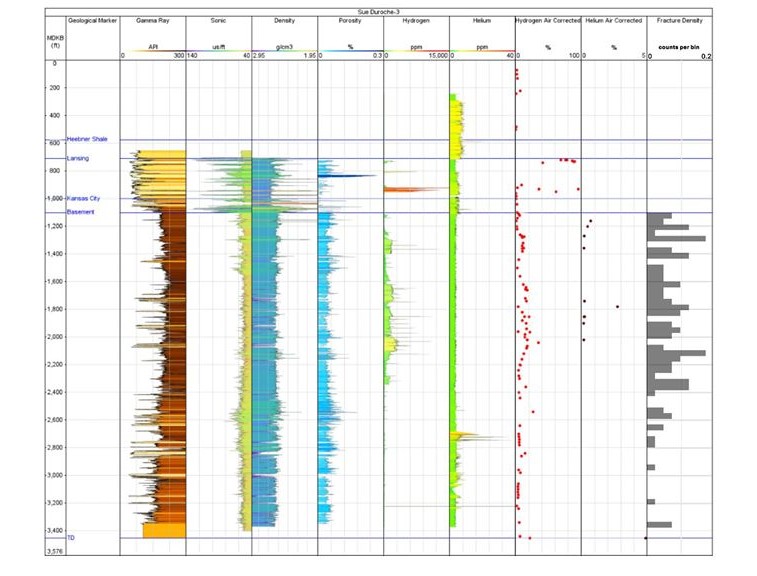The detection of hydrogen concentrations exceeding 96% and helium up to 5% in mud gas samples from HyTerra’s recently drilled Sue Duroche 3 well marks a notable development for natural hydrogen exploration in North America.
With its 100% owned Nemaha Project in Kansas, HyTerra is pursuing one of the most advanced investigations into white hydrogen potential in the U.S.—a region historically associated more with conventional hydrocarbons and industrial helium production than with nascent clean energy solutions.
The well, drilled to a total depth of 3,453 feet in May 2025, is part of a year-long, Fortescue-backed exploration program led by HyTerra’s subsidiary, HYT Operating LLC. Its findings are poised to shape early technical benchmarks in the still-immature field of natural hydrogen—hydrogen formed geologically and extracted from subsurface reservoirs.
Real-time mud gas logs recorded by Schlumberger (SLB) during drilling operations showed elevated hydrogen readings in the sedimentary rock layers and upper basement formations. Subsequent laboratory analysis by Isotech Laboratories confirmed hydrogen concentrations surpassing 96%—well above detection noise and potentially pointing to a high-purity resource. Simultaneously, helium concentrations up to 5% were confirmed in gas samples from the deeper basement interval, particularly between 2,700 and 2,800 feet.
Such figures are significant. In the U.S., natural gas streams containing as little as 0.3% helium are often considered commercially viable for helium extraction. The presence of 5% helium—over ten times that baseline—suggests that Sue Duroche 3 intersects a zone with not only elevated hydrogen but a potentially economic helium stream. Given helium’s strategic importance for semiconductors, medical imaging, and defense applications, this dual-resource potential could add considerable value to HyTerra’s Kansas acreage.
But while the geochemical indicators are promising, commerciality remains far from assured. No flow tests have been conducted yet to confirm the deliverability or sustainability of the hydrogen and helium reservoirs. For now, the Sue Duroche 3 site has been repurposed into a long-term gas and pressure monitoring well. HyTerra’s strategy is to collect dynamic data over time—vital input ahead of any extended production tests or investment decisions.
Petrophysical interpretations are ongoing. Consultants reviewing wireline logs and rotary sidewall cores have identified dolomitization in the carbonate sediments and matrix porosity across several lithologies, including open fractures in the Precambrian basement. These features are considered essential for enabling fluid mobility and accumulations in unconventional gas plays.
Geologically, the Nemaha Ridge region has long been overlooked by modern exploration. Yet it may now host the convergence of deep geochemical processes and technical conditions conducive to natural hydrogen formation—such as water-rock reactions in ultramafic or granitic basement rocks. That the hydrogen signal at Sue Duroche 3 appears strongest in shallow sedimentary units and the upper basement could suggest complex migration and trapping dynamics rather than a simple in-situ generation model.
Helium, meanwhile, is more familiar terrain in Kansas. The state sits within proximity of the Hugoton gas field—one of the largest conventional natural gas and helium sources in U.S. history. Existing infrastructure, regional service capacity, and a regulatory environment already attuned to helium recovery could accelerate project timelines if further appraisal confirms commercial-grade accumulations.
HyTerra’s work also comes amid growing investor interest in geologic hydrogen globally, driven by its promise of ultra-low emissions and low-cost production relative to electrolytic or methane-based hydrogen. However, the sector remains at an early stage, with commercial proof points still scarce and subsurface variability high. France, Mali, and Australia are among other jurisdictions currently investigating white hydrogen plays, but Kansas—with its legacy of helium production and deep drilling knowledge—may prove a favorable testbed.
With backing from Fortescue Future Industries, HyTerra now controls over 100% of the leases in its Nemaha Project and holds a minority stake in a Nebraska-based joint development. The company suggests that both projects could, in the future, be linked to existing ammonia and petrochemical offtakers, although no such arrangements have yet been confirmed.
Stay updated on the latest in energy! Follow us on LinkedIn, Facebook, and X for real-time news and insights. Don’t miss out on exclusive interviews and webinars—subscribe to our YouTube channel today! Join our community and be part of the conversation shaping the future of energy.
